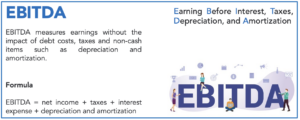Home |
Maximizing Your Company’s Value: Understanding EBITDA

Home |

EBITDA is one of the most scrutinized metrics in the mergers and acquisitions process.
During negotiations in the context of an M&A transaction, buyers and sellers evaluate several factors to agree on a price that accurately reflects the value of a business.
EBITDA (Earnings Before Interest, Taxes, Depreciation, and Amortization) is used to measure a company’s performance. It shows whether a business is profitable by revealing the amount of its normalized operational earnings.
Today’s article covers the following points:
To dive deeper into this topic, contact us to download the eBook. To receive articles like this directly in your inbox, subscribe to our newsletter.

EBITDA serves multiple purposes beyond the M&A sale process. It is a key valuation metric for traders, analysts, and portfolio managers, and lenders use it to assess a company’s ability to meet its debt obligations. However, while EBITDA provides insight into financial performance, it does not fully reflect a company’s true value or performance.
If you are considering selling your business, understanding how EBITDA is calculated can help you present your company’s financials in a way that makes your company’s post-sale cash flow attractive to buyers.
Investors often use EBITDA to assess a company’s enterprise value, with buyers typically paying a multiple of EBITDA in M&A exits.
There is a misconception that EBITDA is synonymous with cash flow. EBITDA acts as a proxy for pre-tax operating cash flow, providing an estimate of the cash flows that might be expected after an M&A transaction. By excluding depreciation, amortization, debt, and taxes, EBITDA provides buyers with a more standardized way to compare companies within their industries. It captures a company’s earnings without taking into account capital expenditures or interest, making it a useful, if imprecise, proxy for cash flow.
Adjusted EBITDA accounts for certain non-recurring, non-operating, or unusual expenses or revenues to provide a clearer picture of a company’s true operating performance. These adjustments are made to normalize EBITDA and more accurately reflect the company’s core profitability, particularly in the context of an M&A transaction or when assessing the company’s ongoing financial health.
Common adjustments to EBITDA may include:
Adjusted EBITDA is particularly important in M&A transactions because it aims to present a more realistic view of what the company’s earnings could look like under new ownership or in future periods, helping to determine a fair valuation.